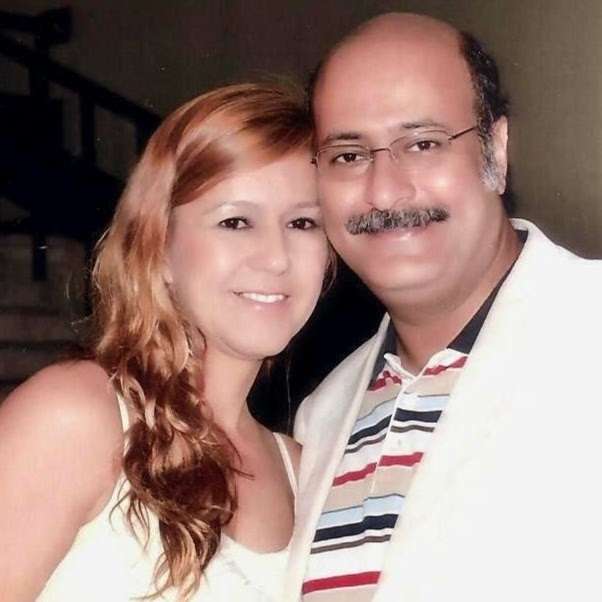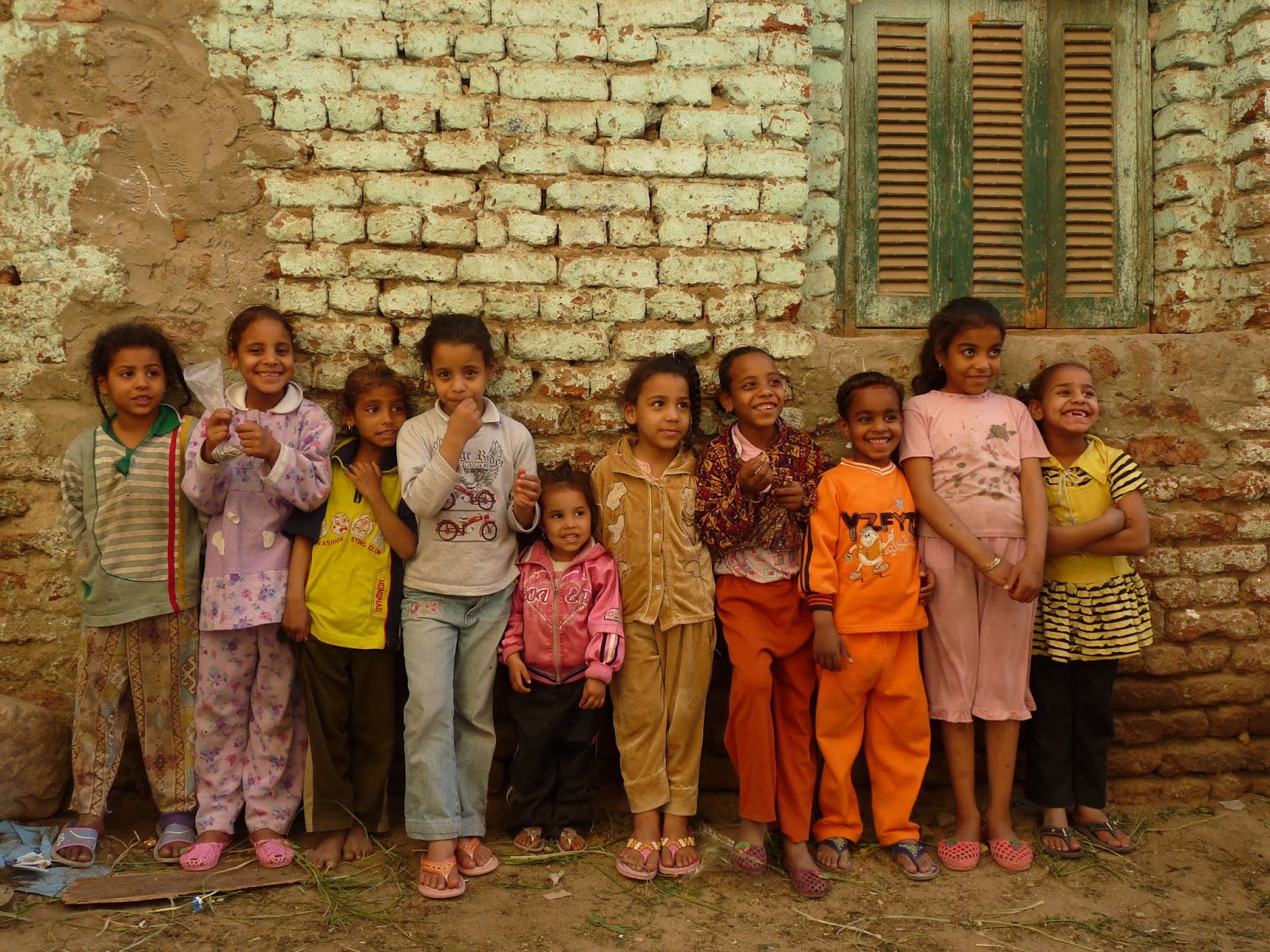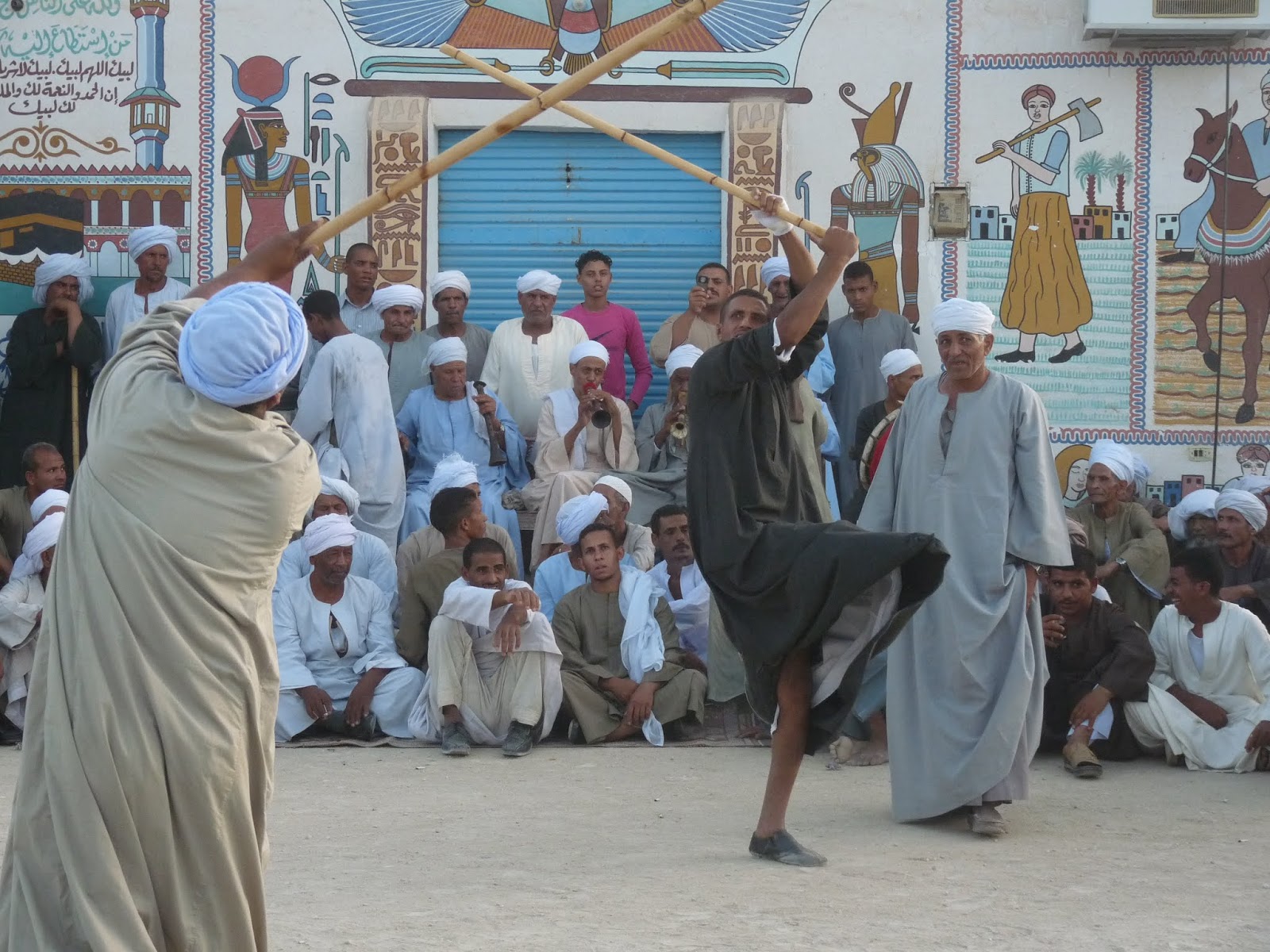A new documentary called Children of the Nile marks
another chapter of the ongoing French interest in Egyptian heritage whether it
is ancient or modern. Its French director Aurélie Chauleur, who graduated from
the University of Sophia Antipolis in Nice, began her career as a music producer
in Paris then worked as a coordinator of the Festival of Polyphonic Meeting in
Corsica. These experiences gave her a taste for travel that started by
exploring the Indian subcontinent in 2006 where she discovered its music and
culture. While working with traditional musicians and street children to
produce albums and videos, Chauleur also joined the Delhi-based NGO “Going to
School” in a humanitarian campaign entitled “Girl Star” which aimed for girls’
education in India. Now based in Paris, Chauleur continues to work for cultural
festivals while using her camera in personal projects related to music and
children. After Mozambico, Sketching the Music, her first documentary on
the traditional music of Mozambique, Chauleur is currently making a series of
poetic documentaries by children and for children. Children of the Nile
is the first one with an intended follow-up in Morocco and another in India.
another chapter of the ongoing French interest in Egyptian heritage whether it
is ancient or modern. Its French director Aurélie Chauleur, who graduated from
the University of Sophia Antipolis in Nice, began her career as a music producer
in Paris then worked as a coordinator of the Festival of Polyphonic Meeting in
Corsica. These experiences gave her a taste for travel that started by
exploring the Indian subcontinent in 2006 where she discovered its music and
culture. While working with traditional musicians and street children to
produce albums and videos, Chauleur also joined the Delhi-based NGO “Going to
School” in a humanitarian campaign entitled “Girl Star” which aimed for girls’
education in India. Now based in Paris, Chauleur continues to work for cultural
festivals while using her camera in personal projects related to music and
children. After Mozambico, Sketching the Music, her first documentary on
the traditional music of Mozambique, Chauleur is currently making a series of
poetic documentaries by children and for children. Children of the Nile
is the first one with an intended follow-up in Morocco and another in India.
To realize the film, Chauleur
travelled to Luxor in Upper-Egypt and particularly to the village of Abu Djoud,
not far from Karnak Temple, where she met Mohamed Mourad and his large family
of gypsy musicians called Matagils. Mourad
got married six times and now he has 55 grandchildren and altogether they form
a band they call “Musicians of the Nile”, that frequently performs in special
occasions and festivities according to the Upper-Egyptian habits. Chauleur and
her camera followed the whole family and its grandchildren to discover their
daily life, community and traditions. An interview:
travelled to Luxor in Upper-Egypt and particularly to the village of Abu Djoud,
not far from Karnak Temple, where she met Mohamed Mourad and his large family
of gypsy musicians called Matagils. Mourad
got married six times and now he has 55 grandchildren and altogether they form
a band they call “Musicians of the Nile”, that frequently performs in special
occasions and festivities according to the Upper-Egyptian habits. Chauleur and
her camera followed the whole family and its grandchildren to discover their
daily life, community and traditions. An interview:
AWAD: How did you get interested in Mourad family? How
you did track them down?
you did track them down?
CHAULEUR: It was Alain Weber, artistic director of “Fès”
Festival in Morocco and “Les Orientales” Festival for “Cité de la Musique “in
Paris, who created the Musicians of the Nile and who introduced me to Mohamed
Mourad and his band of children in France back in 2010 while they were touring.
I then accompanied him to Luxor in August 2011 to gather Sufi singers for a
special performance which took place in Museum of Quai Branly in June 2012 under
the name of “at the Sufi heart of the Nile”. Arriving there, I started to shoot some images
and spent some time with Mourad family. After this journey, I edited a 14 min footage
which was the basis of this 46 min documentary that was screened in the 2012
edition of “Les Orientales” Festival.
Festival in Morocco and “Les Orientales” Festival for “Cité de la Musique “in
Paris, who created the Musicians of the Nile and who introduced me to Mohamed
Mourad and his band of children in France back in 2010 while they were touring.
I then accompanied him to Luxor in August 2011 to gather Sufi singers for a
special performance which took place in Museum of Quai Branly in June 2012 under
the name of “at the Sufi heart of the Nile”. Arriving there, I started to shoot some images
and spent some time with Mourad family. After this journey, I edited a 14 min footage
which was the basis of this 46 min documentary that was screened in the 2012
edition of “Les Orientales” Festival.
AWAD: How many days you spent to shoot Children of the
Nile?
Nile?
CHAULEUR: 80% of the documentary was shot in the course 6
days last March. Some images come from my first trip in August 2011 when I
stayed with them for 10 days.
days last March. Some images come from my first trip in August 2011 when I
stayed with them for 10 days.
AWAD: How did you research this documentary?
CHAULEUR: My idea was to make a film for children by the
children. So when I was in India in the beginning of 2012, I showed the 14 min
footage to Indian children living in villages and slums where I was giving some
classes. I then asked them what they would like to know about those Egyptian
children. They wanted to know a lot of details: the way their houses look like,
their animals, how they eat, what they eat, do they go to school, what games they
are playing, how their music sounds like, how they interact with each other,
etc… Back to Egypt, I could not direct the whole family to perform in front of
the camera in such short period.
However, they were used to my camera and I just followed them in their
daily life while being sure I was covering what the Indian children asked me.
Since I did not know the language, I had to follow my intuition a lot. Living
with them made me understand more easily their space. They really welcomed me
like I was part of the family.
children. So when I was in India in the beginning of 2012, I showed the 14 min
footage to Indian children living in villages and slums where I was giving some
classes. I then asked them what they would like to know about those Egyptian
children. They wanted to know a lot of details: the way their houses look like,
their animals, how they eat, what they eat, do they go to school, what games they
are playing, how their music sounds like, how they interact with each other,
etc… Back to Egypt, I could not direct the whole family to perform in front of
the camera in such short period.
However, they were used to my camera and I just followed them in their
daily life while being sure I was covering what the Indian children asked me.
Since I did not know the language, I had to follow my intuition a lot. Living
with them made me understand more easily their space. They really welcomed me
like I was part of the family.
AWAD: What was the feedback about the documentary where
it was screened?
it was screened?
CHAULEUR: The French children really enjoyed it. I’m waiting
to show it to the Indian children who helped me researching it this coming
February. I guess I will have different comments depending on the whereabouts of
the audience, whether from a rural or from an urban background. When I
organized an interactive exhibition to complete the traveling experience, I
asked the French children what they liked about the documentary … They were
very enthusiastic about their music, about their sweets and drinks, their
animals and especially their relation with the horse, they also liked the tanura
dance, the magician, the house, the clothes, they liked the fact they have a
different way of living. The adults also appreciated the tone of the documentary
because they felt going back to their own childhood. Some of them also knew the
musicians although they never went to Egypt and were happy to see their entire
family and its grandchildren.
to show it to the Indian children who helped me researching it this coming
February. I guess I will have different comments depending on the whereabouts of
the audience, whether from a rural or from an urban background. When I
organized an interactive exhibition to complete the traveling experience, I
asked the French children what they liked about the documentary … They were
very enthusiastic about their music, about their sweets and drinks, their
animals and especially their relation with the horse, they also liked the tanura
dance, the magician, the house, the clothes, they liked the fact they have a
different way of living. The adults also appreciated the tone of the documentary
because they felt going back to their own childhood. Some of them also knew the
musicians although they never went to Egypt and were happy to see their entire
family and its grandchildren.
AWAD: Did you feel that these rural areas have lack of
education?
education?
CHAULEUR: It’s actually in Luxor itself so I would not say
it’s in a rural area. But yes they still live in a gipsy style and the
education is not the most important for them. They would rather teach music to
their children because it’s their way of earning. What is most frustrating for
me as a woman is the gender difference between boys and girls.
it’s in a rural area. But yes they still live in a gipsy style and the
education is not the most important for them. They would rather teach music to
their children because it’s their way of earning. What is most frustrating for
me as a woman is the gender difference between boys and girls.
AWAD: You have big interest in Oriental arts and music
heritage in Upper-Egypt. When did it start?
heritage in Upper-Egypt. When did it start?
CHAULEUR: I’m very much interested in traditional music from
all over the world as I was working in this field for the last ten years as a
producer. I feel it’s very important to highlight Oriental arts in this context
of globalization when everything tends to get standardized. The Sufi singers
from Upper-Egypt we auditioned in Mohamed Mourad’s house for this special
performance in Paris were all very interesting and deserve all international
exposure. But transmission is as important as exposure. And giving a clue about
the culture around the Oriental arts to children today with this documentary,
in France or in other countries, give them the curiosity to discover this kind
of music. I could see that in the exhibition where visiting children wanted to
try the instruments and listening to the musicians live. So the interest
generated will give space to more artists. As producers, we have a role in
preserving the heritage between generations and we try as much to help the
artists teaching their own children. I’m for instance involved in learning
center for the new generation of a specific community with the Sarojini Trust. It is set in a small Indian village called Pugal
at the border with Pakistan.
all over the world as I was working in this field for the last ten years as a
producer. I feel it’s very important to highlight Oriental arts in this context
of globalization when everything tends to get standardized. The Sufi singers
from Upper-Egypt we auditioned in Mohamed Mourad’s house for this special
performance in Paris were all very interesting and deserve all international
exposure. But transmission is as important as exposure. And giving a clue about
the culture around the Oriental arts to children today with this documentary,
in France or in other countries, give them the curiosity to discover this kind
of music. I could see that in the exhibition where visiting children wanted to
try the instruments and listening to the musicians live. So the interest
generated will give space to more artists. As producers, we have a role in
preserving the heritage between generations and we try as much to help the
artists teaching their own children. I’m for instance involved in learning
center for the new generation of a specific community with the Sarojini Trust. It is set in a small Indian village called Pugal
at the border with Pakistan.
AWAD: Right now in Egypt with its current Islamic rule,
there are some voices that try to ban music and arts. Do you feel this will
affect similar families that do music for a living?
there are some voices that try to ban music and arts. Do you feel this will
affect similar families that do music for a living?
CHAULEUR: Yes of course it will. And let’s be honest, for
this family for instance, though its musicians are very famous abroad and
traveled already all over the world, they also need to play their music in the
touristic places for a living. With the current political situation, tourism is
in decline. Now banning music and arts is even worse… I can’t imagine those
families doing something else for a living. Marriages, mawleds, how can
those traditional celebrations survive without music?
this family for instance, though its musicians are very famous abroad and
traveled already all over the world, they also need to play their music in the
touristic places for a living. With the current political situation, tourism is
in decline. Now banning music and arts is even worse… I can’t imagine those
families doing something else for a living. Marriages, mawleds, how can
those traditional celebrations survive without music?
AWAD: How did you compile the soundtrack of the film?
CHAULEUR: I used a few tracks of the album “Down by the River”
from “The Musicians of the Nile” published by the music label “Long Distance”
in 2006: “Al Bahr al-Zama” from Mohamed Mourad, “Taksim al-Hama” from Mustafa
Abdel Aziz and “Ya maawad men sabar” from Yunis-al-Hilali. And the last song in
the documentary is by Mahmoud Gomaa whom you see as well and who performed it in a wedding when I was there.
from “The Musicians of the Nile” published by the music label “Long Distance”
in 2006: “Al Bahr al-Zama” from Mohamed Mourad, “Taksim al-Hama” from Mustafa
Abdel Aziz and “Ya maawad men sabar” from Yunis-al-Hilali. And the last song in
the documentary is by Mahmoud Gomaa whom you see as well and who performed it in a wedding when I was there.



